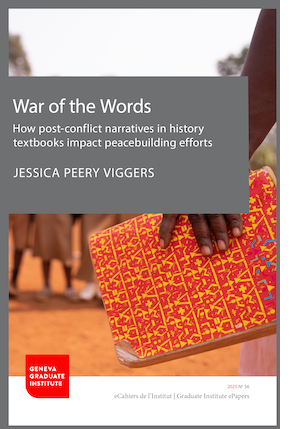How did you come to choose your research topic?
Several factors led me to my choice of topic. To a certain extent, family history played a large role. My maternal grandparents were both Holocaust survivors who emigrated to the US after the war. I grew up hearing stories of concentration camps not only in the classroom, but in the living room at family gatherings. I remember my great-aunt telling of how she tried to escape to Switzerland but got betrayed at the border and sent to Auschwitz instead. In that sense, it almost felt poetic to take my time here in Switzerland to contribute to the field of genocide studies in some way. Additionally, I had been a teacher in the years prior to coming to the Geneva Graduate Institute and really wanted to focus on the role education plays in promoting long-lasting peace in societies recovering from conflict. I feel really lucky with my choice of advisor, Professor Chanwoong Baek, who helped take my broad ideas and narrow them down into something that was not only feasible to research, but helped fill a gap in the current body of research on post-conflict education.
Can you describe your thesis questions and your methodology?
The central question my thesis seeks to answer is in what ways do narratives disseminated through official educational channels, in this case textbooks, support or detract from peacebuilding efforts in post-conflict contexts. To do this, I examined all the government textbooks currently in circulation for secondary school students in Rwanda. I felt Rwanda was the right choice for a case study country for a variety of reasons. Writing my thesis on the eve of the thirtieth anniversary of the 1994 Genocide against the Tutsi, none of the students targeted by the textbooks would have been alive during the conflict but the memory may still linger in their families and communities. Additionally, the Rwandan government provides the full set of textbooks and teacher’s guides for download on the Rwanda Basic Education Board website, allowing for an up-to-date and comprehensive view of what current students are using at every level of secondary school.
For my data collection, I read each of the six textbooks, identifying recurring themes in the texts via a colour-coded system. Once I began analysing the data, I broke down my findings into three categories. In the first category, I recorded every time the word “genocide” was used across the textbooks as a measure of its prevalence in the history curriculum in Rwanda. I then looked at the textbook chapters specifically covering the conflict, including the pre- and post-conflict periods, to gain a greater understanding of the flow of the curriculum, which is especially important in contexts where most students leave school before completion of the entire curriculum. Building upon these analyses, I explored common themes found in the narratives taught such as the de-emphasis of ethnic labels or the characterisation of different actors in and around the conflict.
What are your major findings?
It is difficult to characterise the education surrounding the 1994 Genocide against the Tutsi in Rwanda as either entirely supportive of or detracting from the peacebuilding process, and attempting to do so would be at odds with reality. Elements of both can be found intertwined throughout all six textbooks. The conflict is clearly very prevalent in the curriculum, its presence not limited to the pages explicitly designated for its discussion. Rather, it has become the centre-point of Rwandan history. The goal of its inclusion, however, may not be as simple as promoting peace within the country as other motivations may guide the way narratives are presented. In the Rwandan context, the apparent motivation seems to be garnering support for the current ruling party. As an example, following the logic of Federman (2016), the narrative cleanly distinguishes between protagonist and antagonist in a way that elevates the heroism of the Rwandan Patriotic Army in the face of a long list of actors relegated to villainhood. Victims as well are clearly defined, with the inclusion of moderate Hutus in the narrative – a welcome change from previous versions of the textbooks which erased Hutu victims, as noted by Henry (2016). Nevertheless, students are warned against the dangers of considering any narratives that stray from what has been presented; they are taught to outright reject anything contrary to what they have been taught, even if it comes from members of their own family, which may limit the efficacy of education as a peacebuilding tool.
This is just one case study, with wounds still relatively fresh. However, in understanding how different motivations that may be present within a country impact the way post-conflict education is disseminated, international advisors can be led to give guidance that more effectively balances the needs of local actors with best practices in peacebuilding education.
What are you doing now?
I am currently interning in the field of communications at the International Air Transport Association (IATA) and will be seeking longer term employment in the non-profit sphere upon completion of my internship.
* * *

Peery Viggers, Jessica. War of the Words: How Post-conflict Narratives in History Textbooks Impact Peacebuilding Efforts. Graduate Institute ePaper 56, Graduate Institute Publications, 2025. https://doi.org/10.4000/13azb.
Jessica Peery Viggers recently completed her studies at the Geneva Graduate Institute as part of the Master in International and Development Studies programme under the Conflict, Peace, and Security specialisation. She completed her undergraduate degree at the University of St. Thomas in St Paul, USA, where she was a member of the Pi Sigma Alpha National Political Science Honor Society and the Beta Gamma Sigma International Business Honor Society. Her previous research has ranged from the stability of political alliances in non-democratic regimes to the application of international humanitarian law in civilian internment camps to the impact of post-conflict education on peacebuilding.
* * *
Banner image by Media Lens King/Shutterstock.
Interview by Nathalie Tanner, Research Office


